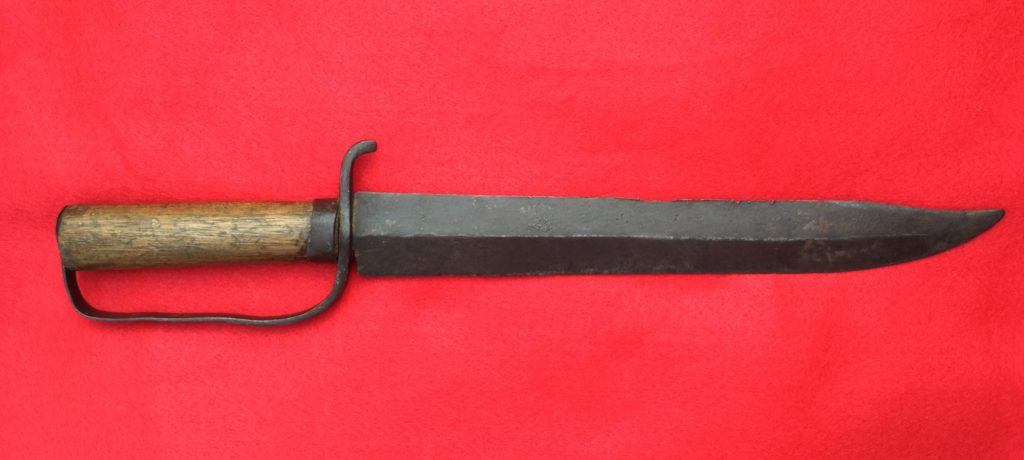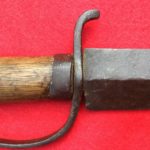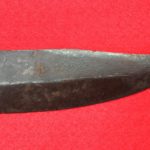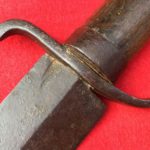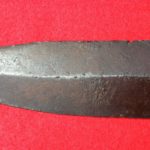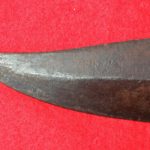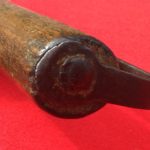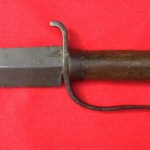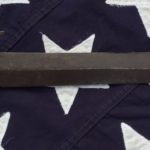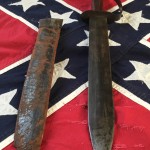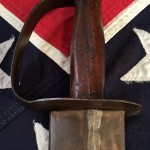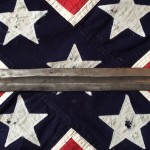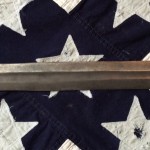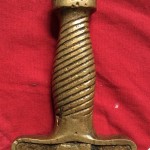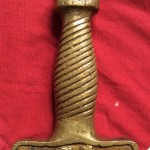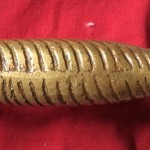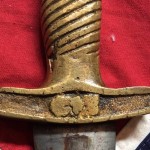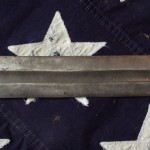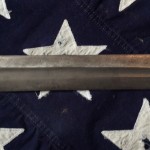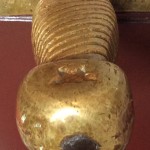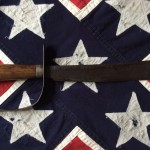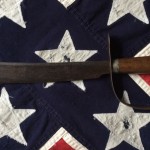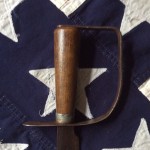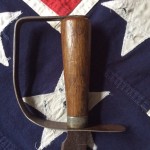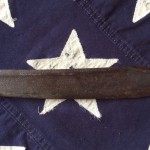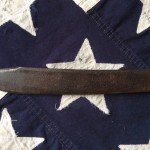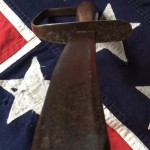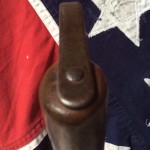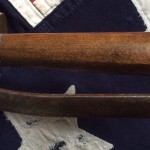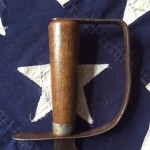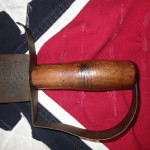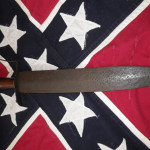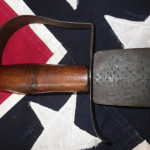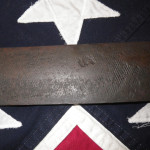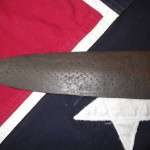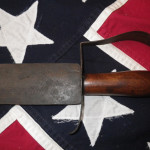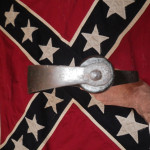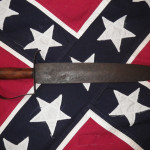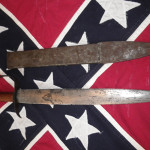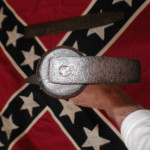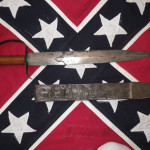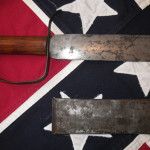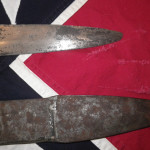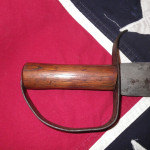-
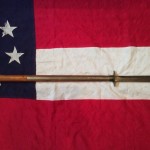
-
Confederate Joesph Brown Georgia Pike , Spear Point Blade
-
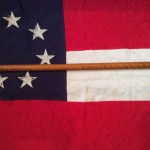
-
Confederate Pike, Wood Shaft
-
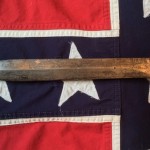
-
Confederate Georgia Pike Blade
-
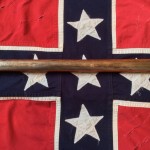
-
Confederate Georgia Pike
-
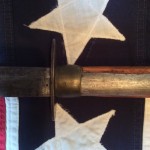
-
Joseph Brown Georgia Pike
-
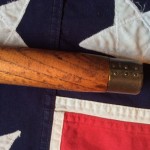
-
Confederate Pike, Base Collar
-
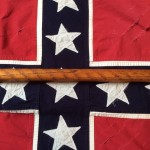
-
Southern Pike, Rope Markings
The outbreak of the war left the the Southern states without much of the resources there Northern counterparts had. Rifles, pistols, swords, uniforms and least we forget people were just some of the needs lacking to fight a war. Because of this the ingenuity of the Southern war machine, i.e. politicians, blacksmiths, mechanics and farmers would have to think outside the box.
In February of 1862, Georgia Governor Joseph Brown gave an address to mechanics throughout the state.
Executive Department,
Milledgeville, Georgia,
February 20th, 1862.
To the Mechanics of Georgia:
The late reverses which have attended our arms, show the absolute necessity of renewed energy and determination on our part. We are left to choose between freedom at the end of a desperate and heroic struggle and submission to tyranny, followed by the most abject and degraded slavery to which a patriotic and generous people were ever exposed. Surely we can not hesitate. Independence or death should be the watchword and reply of every freeborn son of the South. Our enemies have vastly superior numbers and greatly the advantage in the quantity and quality of their arms. Including those, however, which have and will be imported, in spite of the blockade, we have guns enough in the Confederacy to arm a very large force, but not enough for all the troops which have been and must be called to the field. What shall be done in this emergency? I answer: Use the “Georgia Pike” with six feet staff, and the side knife eighteen inches blade, weighing about three pounds.
Let every army have a large reserve, armed with a good pike, and a long heavy side knife, to be brought upon the field, with a shout for victory, when the contending forced are much exhausted, or when the time comes for the charge of bayonets. When the advancing columns come within reach of the balls, let them move in double quick time and rush with terrible impetuosity into the lines of the enemy. Hand to hand, the pike has vastly the advantage of the bayonet, and those having the bayonet, which is itself but a crooked pike, with shorter staff, must retreat before it. When the retreat commences, let the pursuit be rapid, and if the enemy throw down their guns and are likely to outrun us, if need be, throw down the pike and keep close at their heels with the knife, till each man has hewed down, at least, one of his adversaries.
Had five thousand reserves thus armed and well trained to the use of these terrible weapons been brought to the charge at the proper time, who can say that the victory would not have been ours at Fort Donaldson?
But it was probably important that I state here the use to be made of that which I wish you to manufacture. I have already a considerable number of these pikes and knives, but I desire, within the next month, ten thousand more of each. I must have them; and I appeal to you, as one of the most patriotic classes of our fellow citizens, to make them for me immediately. I trust every mechanic, who has the means of turning them out rapidly, and the owner of every machine shop in this State, will at once lay aside, as far as possible, all other business and appropriate a month or two to the relief of the country in this emergency. Each workman who has the means of turning them out in large numbers without delay will be supplied with a proper pattern by application at the Ordinance Office at Milledgeville.
Appealing to your patriotism as a class and to your interest as citizens, whose all is at stake in the great contest in which we are engaged, I ask an immediate response.
In ancient times, that nation, it is said, usually extended its conquests furthest whose arms were shortest. Long range guns sometimes fail to fire and waste an hundred balls to one that takes effect; but the short range pike and the terrible knife, when brought within their proper range, ( as they can be almost in a moment) and wielded by a stalwart patriot’s arm, never fail to fire and never waste a single load.
I am, very respectfully, your fellow citizen,
After reading such a decree you can better understand the sentiment and feelings of the Southerner at the time of the war. The institutions have dumbed down the facts since the War of Northern Aggression with political correctness. But it’s obvious that the Southerner was defending his freedoms, they were fighting the second revolution the same fight there Grandfathers had fought some 80 years earlier against the British.
Calling for mechanics throughout the state to make six foot staffs with eighteen inch blades shows just how desperate the Southern war machine was. Still thinking in terms of a Napoleonic type war, where armies lined up in open fields with smooth bore rifles and blades of all types believing a Divine Spirit was on there side and would protect them the sorrows of death.
There Northern counterparts were manufacturing state of the art breech loading repeating carbines and rifles, rifled cannons that could launch explosive projectiles accurately for miles, building the largest wartime Navy the world had ever seen.
Seems hard to believe that these two countries/armies could have been fighting against each other with such a difference in the types of weapons they hoped would bring them victory. It’s a credit to the South that the war lasted as long as it did, just goes to show how difficult it is to strip someone of there freedom without them fighting back like a caged rabbit dog, after all they were willing to use pikes against men with guns, sounds crazy too me.
Which brings me to the next weapon in the Civil War Arsenal. This Joseph Brown Georgia Pike has a spear point blade that measures 12 ¼” long, the overall length of the pike is 8’ & ¼” from the butt to the point of the blade. It has no cracks in the wood shaft and no makers marks, which is not uncommon for these pikes. The brass butt collar at the base of the shaft is still in place, which is generally lost on most examples. The wood shaft has what appears to be the markings ( indentations ) of rope that was once wrapped around it. I’ve seen this before on other pikes and it’s my opinion that the shaft was wrapped with rope to better grasp for lungeing forward. However I’ve never seen a pike with the rope still in place. This pike was purchased from Sam, at the Horse Soldiers store in Gettysburg Pa. I’m guessing due to its great condition it was a war souvenir shipped north after the war and displayed at a G.A.R hall, just an educated guess.
So there you have it another fine example of a Southern Edged Weapon in the ever growing Civil War Arsenal, a Confederate Georgia Pike. If you have any questions about this weapon feel free to contact me. And if you have a civil war weapon that you’d like know more about or perhaps you’d like to sell feel free to contact me at civilwararsenal@yahoo.com , attn: Eugene West. Thanks for stopping by.
